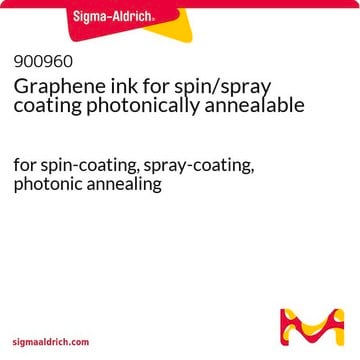739332
PEDOT:PSS
high-conductivity grade, 1.1% aqueous dispersion, surfactant-free
Synonym(e):
PEDOT:PSS, Poly-(2,3-dihydrothieno-1,4-dioxin)-poly-(styrolsulfonat)
About This Item
Empfohlene Produkte
product name
Poly(3,4-ethylendioxythiophen)-poly(styrolsulfonat), 1.1% in H2O, surfactant-free, high-conductivity grade
Qualität
high-conductivity grade
Form
liquid
Grünere Alternativprodukt-Eigenschaften
Design for Energy Efficiency
Learn more about the Principles of Green Chemistry.
sustainability
Greener Alternative Product
Konzentration
1.1% in H2O
Widerstand
<100 Ω/sq, <80% visible light transmission (40μm wet)
Brechungsindex
n20/D 1.334
pH-Wert
<2.5
Viskosität
30-100 cP(20 °C)
Dichte
0.999 g/mL at 25 °C
Grünere Alternativprodukt-Kategorie
Lagertemp.
2-8°C
Suchen Sie nach ähnlichen Produkten? Aufrufen Leitfaden zum Produktvergleich
Allgemeine Beschreibung
Anwendung
Rechtliche Hinweise
Signalwort
Danger
H-Sätze
Gefahreneinstufungen
Eye Dam. 1 - Skin Corr. 1B
Lagerklassenschlüssel
8B - Non-combustible corrosive hazardous materials
WGK
WGK 3
Flammpunkt (°F)
Not applicable
Flammpunkt (°C)
Not applicable
Analysenzertifikate (COA)
Suchen Sie nach Analysenzertifikate (COA), indem Sie die Lot-/Chargennummer des Produkts eingeben. Lot- und Chargennummern sind auf dem Produktetikett hinter den Wörtern ‘Lot’ oder ‘Batch’ (Lot oder Charge) zu finden.
Besitzen Sie dieses Produkt bereits?
In der Dokumentenbibliothek finden Sie die Dokumentation zu den Produkten, die Sie kürzlich erworben haben.
Kunden haben sich ebenfalls angesehen
Artikel
A detailed article on conducting polymer materials for flexible organic photovoltaics (OPVs) applications.
In the field of organic printable electronics, such as OLEDs and organic photovoltaics (OPVs), improved organic conducting and semiconducting materials are needed. The progress in two fields is reviewed in this article.
Conducting polymers such as polyaniline, polythiophene and polyfluorenes are now much in the spotlight for their applications in organic electronics and optoelectronics.
Advancements in bioelectronics, incorporating self-healing materials for wearable devices, and measuring bioelectric signals to assess physiological parameters.
Unser Team von Wissenschaftlern verfügt über Erfahrung in allen Forschungsbereichen einschließlich Life Science, Materialwissenschaften, chemischer Synthese, Chromatographie, Analytik und vielen mehr..
Setzen Sie sich mit dem technischen Dienst in Verbindung.









